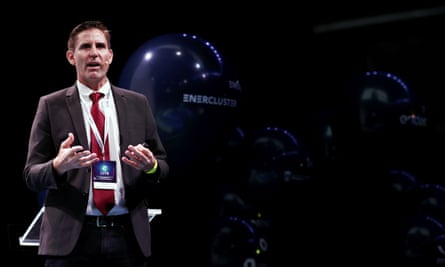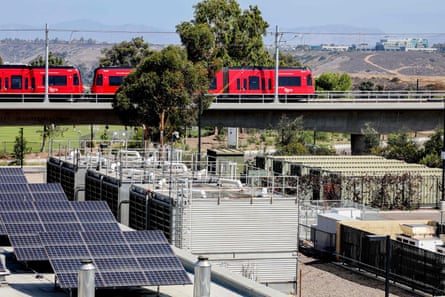“Combustion is the problem – when you’re continuing to burn something, that’s not solving the problem,” says Prof Mark Jacobson.
The Stanford University academic has a compelling pitch: the world can rapidly get 100% of its energy from renewable sources with, as the title of his new book says, “no miracles needed”.
Wind, water and solar can provide plentiful and cheap power, he argues, ending the carbon emissions driving the climate crisis, slashing deadly air pollution and ensuring energy security. Carbon capture and storage, biofuels, new nuclear and other technologies are expensive wastes of time, he argues.
“Bill Gates said we have to put a lot of money into miracle technologies,” Jacobson says. “But we don’t – we have the technologies that we need. We have wind, solar, geothermal, hydro, electric cars. We have batteries, heat pumps, energy efficiency. We have 95% of the technologies right now that we need to solve the problem.” The missing 5% is for long-distance aircraft and ships, he says, for which hydrogen-powered fuel cells can be developed.
Jacobson’s claim is a big one. He is not just talking about a shift to 100% renewable electricity, but all energy – and fossil fuels still provide about 80% of that today. Jacobson has scores of academic papers to his name and his work has been influential in policies passed by cities, states and countries around the world targeting 100% green power. He is also controversial, not least for pursuing a $10m lawsuit against researchers who claimed his work was flawed, which he later dropped.

The evidence that proves he is right is collected in the new book, Jacobson says. Not only is a 100% renewables-powered world possible, it also promises much lower energy bills, he says. The first reason for that is that electrified vehicles, heating and industrial processes are far more efficient than those powered by fossil fuels, where much of the energy is wasted as heat.
Add in better-insulated buildings and ending the drilling and mining for the fossil fuels that consume about 11% of all energy, and you get 56% less energy use on average from 2035 to 2050, Jacobson says. Wind and solar energy are cheaper too, so average bills will fall 63%, he says.
Jacobson divides approaches to the energy transition into two camps: “One says we should just try everything – they’re the ‘all-of-the-above camp’ – and keep investing huge amounts of money in technologies that may or may not be available to work in 10 years. But 10 years is too late.” Carbon emissions must fall by 45% by 2030, scientists agree, to keep on track for no more than 1.5C of global heating.
His camp takes a different approach, Jacobson says: “Let’s focus on what we have and deploy as fast as possible. And we will improve those technologies just by deploying, bringing better solar panels, batteries, electric vehicles and so on. Some people just don’t realise the speed that we need to solve these problems, especially air pollution – 7 million people die every year. We can’t wait.”
However, there are major barriers to a rapid rollout of a 100% renewable energy system, he says: “The No 1 barrier is that most people are not aware that it’s possible. My job is trying to educate the public about it. If people are actually comfortable that it’s possible to do, then they might actually do it.”
He adds: “The policy of all-of-the-above is also a big barrier to a transition. In the US, for example, in the recent [climate legislation], a lot of money was spent on carbon capture, small modular nuclear reactors, biofuels, blue hydrogen. These are all what I consider almost useless, or very low-use, technologies in terms of solving the problems. And yet, a lot of money is spent on them. Why? Because there are big lobby groups.” Another barrier is funding the upfront costs of renewable energy in poorer countries – rich countries need to help, he says.
Jacobson believes progress towards a 100% renewable energy system can be fast: “The goal is 80% by 2030, and 100% by 2050. But, ideally, if we can get 80% by 2030, we should get 100% by 2035 to 2040.”
Solving the stability problem
A big concern about a world overwhelmingly reliant on electricity is maintaining the stability of grids powered by renewables. Where there are large amounts of hydropower from dams this is relatively easy – at least 10 countries already have 100% renewable grids. But in other places reliance on intermittent wind and solar is more challenging. The answer, says Jacobson, is energy storage, managing the demand, and connecting up renewables over wider areas to enable greater continuity of supply.
Storage can be batteries, pumped hydro, flywheels, compressed air and lowering and raising heavy weights. Jacobson thinks batteries will win, but says others could contribute if they can compete on cost. New research indicates that electric vehicle batteries alone could provide the short-term storage needed by global grids as early as 2030.
Jacobson also advocates heat storage for some buildings: “Storing heat in boreholes, aquifers or water pits is dirt cheap, excuse the pun. It’s less than $1 a kilowatt hour of storage.” Managing demand, by varying electricity prices with demand, is already growing fast, he says. When the renewables supply exceeds the demand, the electricity should be used to produce green hydrogen, he says, to power the fuel cells needed by energy-intensive users.

“Managing the grid is just an optimisation problem, not a rocket science problem,” he says. “I don’t want to say there’s zero problems, but usually these challenges are ironed out over time just by experience.”
Another criticism of a major renewables rollout is the mining required for the metals used. But Jacobson says such a rollout would in fact hugely reduce extraction from the earth by ending fossil fuel exploitation: “The total amount of mining that’s going to be needed for wind, water, solar, compared to [the] fossil fuel system, is much less than 1% in terms of the mass of materials.”
Jacobson is scathing about many nascent technologies being promoted as climate solutions. “Carbon capture and storage is solely designed to keep the fossil fuel industry in business,” he says. Only some of the CO2 is captured and buried, he says, and deadly air pollution continues unabated. Blue hydrogen, produced from fossil gas with some CO2 then captured and buried, is far inferior to green hydrogen produced directly from renewable electricity, Jacobson says: “Blue hydrogen is just really convoluted.”
after newsletter promotion
New nuclear plants are too slow to build and too expensive compared with wind and solar, in Jacobson’s view: “You end up waiting 15 to 20 years longer, for a seven to eight times higher electricity price – it just makes no sense. Even if they improve [build times], say to 12 years, that’s still way too long. We have cheaper, faster, safer technologies. Why waste time?”
Biofuels are also dismissed by Jacobson: “The biofuels push was really not helpful. They hold constant, or increase, air pollution and they use a huge amount of land.”
He is a little more measured when it comes to direct air capture (DAC): technologies that can suck CO2 from the air for burial. It has no role today, he says, with spending on renewables far more cost effective in cutting emissions. But even when fossil fuel burning ends, many scientists have concluded that CO2 will have to be drawn from the air to avoid the worst effects of the climate crisis. At that point, Jacobson says, the costs of DAC should be compared with other ways to sequester carbon and limit global heating, such as reforestation and cutting emissions of other more powerful greenhouse gases, including methane from livestock and nitrous oxide from fertilisers.
Supporters and critics
Jacobson’s book has attracted support from some experts. Prof Michael Mann, at the University of Pennsylvania, says the book “presents a comprehensive and detailed blueprint for the options we have right now to address the climate crisis”. Mann has said those insisting we lack the tools to decarbonise the economy today are wrong.
Prof Claudia Kemfert, at the German Institute for Economic Research, who has advised the German government and European Commission, says: “[The book] shows impressively that numerous crises can be killed with one stone, without us having to wait for miracles.”
But others are critical of a focus on only wind, water and solar. Prof Ken Caldeira, at the Carnegie Institution for Science in the US, says: “Having a broader set [of technologies] in the toolbox only makes it easier to solve problems. We will only use the tools that it makes sense to use in any particular circumstance, but maintaining and expanding our options is a good thing.

“The key question is not what is physically possible in an ideal world, but what is practically possible in the world as we know it,” he says.
Prof Rob Gross, the director of the UK Energy Research Centre, is somewhere in the middle of the debate: “I broadly agree that we can largely use existing technologies, but we will need to put those to new applications, such as using bulk stores of hydrogen in order to provide interseasonal storage.”
“Moonshot efforts to invent entirely new things are almost certainly a distraction,” he adds. “Jacobson is right that the principal need is to deploy what we have. He is wrong to the extent he makes this sound easy.”
Asked about the controversy around his work, Jacobson says: “Usually, the people against us don’t like the fact that we don’t include their technologies.” On the lawsuit over a critical paper, he says: “That was not a question of a scientific disagreement.” He claims it was an attempt to protect his reputation. He dropped the case in 2018.
Jacobson remains optimistic: “There is a technical and economic solution to the climate, air pollution and energy security problems we face. But we do have major challenges in trying to implement that solution. The challenges are getting the political willpower to focus on a narrow set of solutions that we can implement quickly. The vested interests are very much a problem because they are pushing this ‘all of the above’ approach.”
No Miracles Needed: How Today’s Technology Can Save Our Climate and Clean Our Air by Mark Z Jacobson is published by Cambridge University Press on 2 February 2023, £11.99.
